
People connect through stories — and case studies are one of the best ways to tell yours. They give potential clients a window into your process, your results, and the value you bring to the table.
In this article, we delve into the significance of case studies and offer proven strategies for crafting impactful narratives.
Examining different types of case studies and learning best practices can provide you with valuable insights to improve your business strategies and craft inspiring success stories.
What is a Case Study?
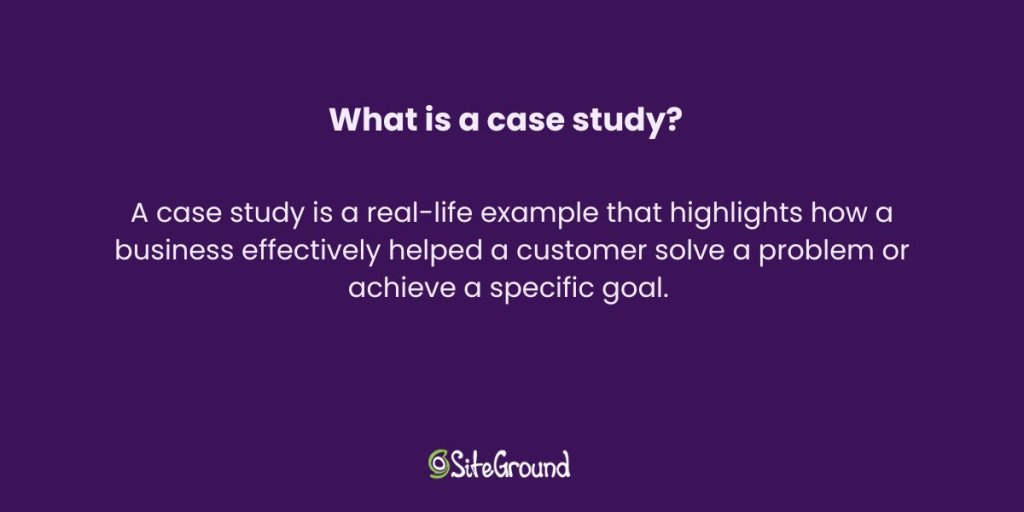
A case study is a real-life example that highlights how a business effectively helped a customer solve a problem or achieve a specific goal. It gives you a clear picture of the challenge tackled, the solution put in place, and the measurable results and benefits that came out of it. Why is this important? It helps potential customers see just how effective the business’s offerings can be.
If you’ve come across terms like “impact report,” “success story,” or “business analysis,” you’re essentially looking at different types of case studies. These labels each shine a light on different aspects of the customer experience—whether it’s the results achieved, the strategic insights gained, or the overall impact of a particular initiative.
So, let’s talk about the four main types of case studies: Descriptive, Explanatory, Exploratory, and Intrinsic. Each one has its own unique purpose, whether it’s detailing specific situations, examining causes and effects, exploring new questions, or focusing on unique cases. Stick around as we explore each of these types in the next section!
What are the Four Types of Case Studies? + Best Examples
Understanding the different types of case studies allows you to choose the right approach for your goals—that could be exploring a new topic, explaining a process, describing a situation, or focusing on a unique scenario. While these categories can sometimes overlap, knowing the distinctions helps clarify your research strategy. In this section, we’ll introduce the four main types of case studies and give examples to show how they’re used.
1. Exploratory Case Studies
Exploratory case studies help identify key questions and discover ways to improve different parts of a business. They gather initial data to understand how people behave and what they prefer. These studies look into new topics and help organizations tackle complex problems. This approach gets you ready to explore how to improve your processes, systems, and overall experience.

Let’s take a look at Convident’s journey with SiteGround, which is a fantastic example of an exploratory case study. This one examines the early steps and decisions that paved the way for the agency’s success. It zooms in on the key questions and challenges they faced when picking a hosting partner, showing why reliable support and standardized operations were so crucial. Through this study, you’ll see how Convident tackled big issues like scalability, efficiency, and building client trust, revealing the nuts and bolts of how they made it all work.
This exploratory case study demonstrates how smart choices and strategic partnerships can shape a small business’s journey. It’s a great resource for agencies looking to optimize and grow sustainably. Convident’s story highlights how these key decisions can make all the difference.
2. Descriptive Case Studies
Unlike exploratory studies, which are more open-ended, descriptive case studies provide a detailed account of a specific subject or phenomenon in its real-life context. They really get into the nitty-gritty, capturing all the details and unique aspects of the subject. These studies paint a clear picture of the situation, setting the stage for further analysis. As we look closer, they give us the context we need to understand how different factors are connected.

Let’s explore Roxana Degiovanni’s journey with SiteGround, a perfect example of a descriptive case study. It details how she found a reliable hosting provider that revolutionized her business operations. As a brand and web designer, Roxana faced technical hurdles until she stumbled upon SiteGround at a WordCamp event.
The study highlights how features like 1-click WordPress installation and strong security were just what she needed. The focus on reliability and performance enabled her to improve client satisfaction and propel business growth.
This case study offers a clear look at the benefits of SiteGround’s hosting solutions, making it a valuable resource for other creative professionals looking to upgrade their workflows and improve client outcomes.
3. Explanatory Case Studies
Explanatory case studies take things a step further than descriptive ones by examining the cause-and-effect dynamics of a specific event or outcome. They’re all about uncovering the reasons and mechanisms behind the results.
While descriptive studies lay out the situation, explanatory ones look closer, aiming to give you insights into what makes everything tick.
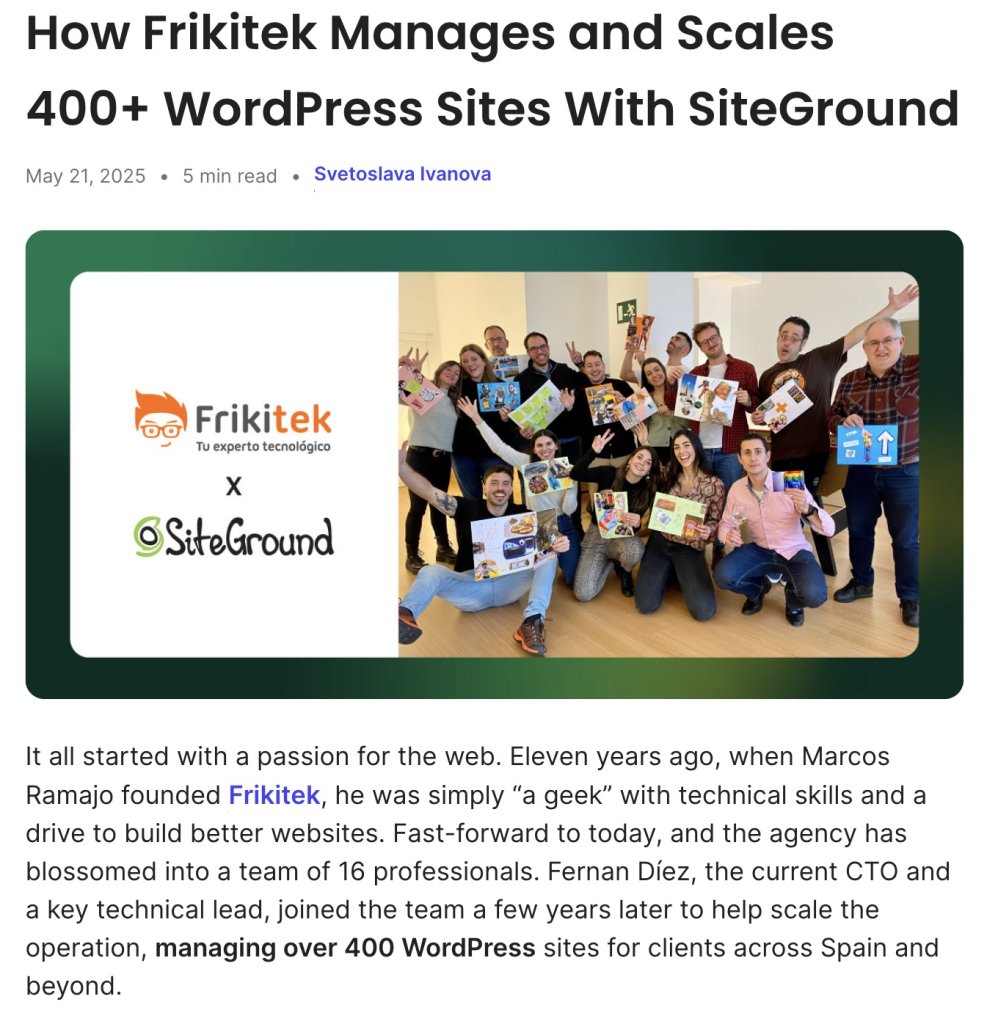
The case study of Frikitek’s experience with SiteGround is a standout example of an explanatory case study. This story shows how Frikitek, a web development agency, tackled the challenge of managing over 400 WordPress sites by switching to SiteGround’s hosting services.
The case study highlights their need for better performance, security, and scalability. With SiteGround’s resource isolation, security infrastructure, and automation tools, Frikitek’s operations saw significant improvements.
This study really shows how adopting SiteGround’s services made a big difference by tackling specific challenges. If you’re an agency looking to make similar improvements, this resource can be incredibly helpful.
4. Intrinsic Case Studies
Finally, intrinsic case studies stand apart by focusing on a specific case, rather than as a representative of other cases. They are all about those unique or unusual cases that really catch a researcher’s eye because of their distinct characteristics. They explore these one-of-a-kind situations, offering specific insights that might not apply to every situation but are fascinating and valuable on their own.

Jonathan Sophie’s experience with SiteGround demonstrates an intrinsic case study example in action. What makes this case so ideal is how it explores his unique path, highlighting the specific challenges and triumphs he encountered as a designer. It focuses on his personal growth and how SiteGround’s services helped him manage creative projects and overcome technical hurdles.
The study shows how SiteGround supported Jonathan’s work and sheds light on his specific challenges and successes. This case is particularly insightful because it takes a close look at a special situation, providing lessons that, while specific, can inspire others facing similar challenges.
Instrumental Case Studies
In addition to the four main types, there are several other common case study approaches that serve different research goals and needs.
Let’s explore instrumental case studies, which offer a different angle compared to the main types we’ve talked about. These studies use a specific case to examine a bigger issue or fine-tune a theoretical framework. Unlike intrinsic case studies that focus on what makes a particular case unique, instrumental studies use the case to get a better grasp of a larger phenomenon.
Looking at a specific instance helps researchers find lessons with wider impact. This approach makes instrumental case studies incredibly valuable for developing theories and understanding how individual cases relate to larger trends.

The story about Marc Perry and his fitness site, BuiltLean, serves as an instrumental case study. Marc’s story is all about how SiteGround’s hosting services helped him slash costs while managing a huge amount of web traffic.
What makes this example so relatable is how it highlights the real-world benefits of cost-efficiency and scalability, offering practical tips on how to optimize your hosting expenses if your business has big online audiences. You’ll find valuable lessons here about discovering cost-effective solutions that truly make a difference. It’s a great reminder of how the right hosting choice can help you grow without breaking the bank.
Collective Case Studies
Next, we have collective case studies, which focus on examining a group of cases, either simultaneously or one after another. This method allows researchers to compare and contrast different situations to identify patterns and differences.
When you look at multiple cases, you get a fuller picture of what’s going on, revealing details that might be missed if you only focused on one case. This method is especially helpful for analyzing complex issues that can show up in different ways depending on the situation.

Let’s take a look at the stories of David Chastain and Holly Boothroyd, which together make for an interesting collective case study. Both are web developers who manage multiple client websites using SiteGround, and their experiences offer a rich knowledge source.
Comparing how they handle hosting for different types of websites helps us uncover patterns and best practices that are helpful for developers and agencies looking to streamline their operations.
What makes these examples so intriguing is how they demonstrate ways to improve client satisfaction with reliable hosting solutions. Their stories provide practical, real-world examples of how effective hosting can make a big difference in managing multiple sites efficiently.
Key Elements of a Case Study Design + Template
Crafting a case study that really hits the mark takes some careful thought and attention to detail. In this section, we’ll walk through the key elements that make a case study truly engaging. We’ll look at everything from pinpointing the challenge to highlighting the results. Let’s jump in and see how to make your case study stand out!
With the right tools, adding your case studies to your website can be simple and effective. The SiteGround Website Builder is not only easy to use, but makes adding case study sections to your website effortless. Start today and make your achievements shine!
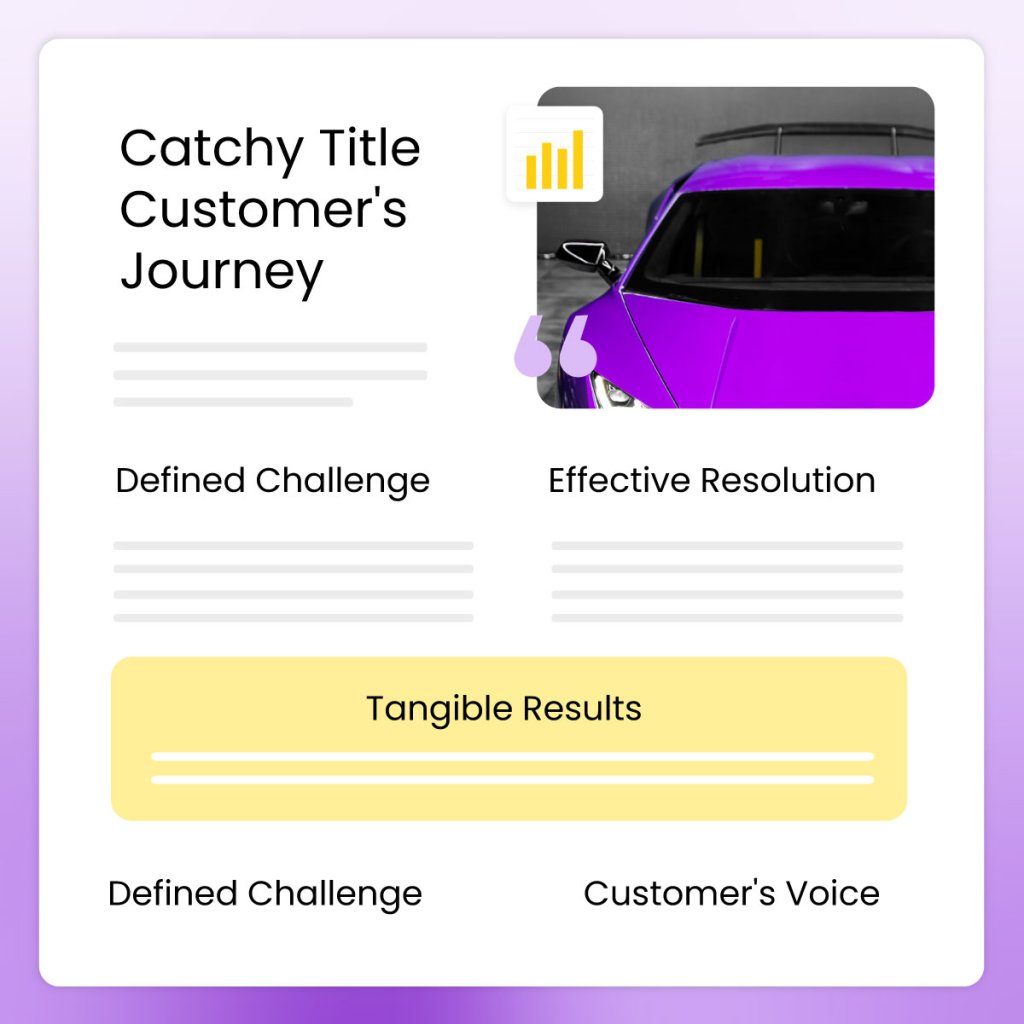
1. Cap It Off with a Great Title
Pick a title that’s short, sweet, and to the point, capturing what the case study is all about. A great title grabs attention and clearly highlights the customer’s journey and the key takeaways.
For instance, “Transforming Business: How SiteGround Boosted Frikitek’s Efficiency” gets right to the heart of the story.
2. Start with A Defined Challenge
Kick things off by pinpointing the common problems or challenges your audience deals with. This helps set the stage for your case study, showing readers that you get where they’re coming from.
For example, if a small café is having trouble with low afternoon traffic, make that the starting point of your story to connect with other businesses facing similar issues.
3. Tell the Story of Your Customer’s Experience
Bring the narrative to life by sharing it through the eyes of your customer. Talk about their journey, emotions, and experiences along the way, so readers can connect on a personal level.
Picture a local artist feeling overwhelmed by managing online sales until they discovered an ecommerce platform that made everything so much easier.
4. Show Your Solution
Highlight how your product or service effectively addressed the customer’s problem. Focus on showcasing your solutions and the unique value you provide, helping potential customers envision how you can assist them, too.
For instance, explain how a cleaning service reduced a hotel’s maintenance costs by implementing eco-friendly cleaning solutions.
5. Give Your Customer a Voice
Highlight the ways your product or service tackled the customer’s issue head-on. Emphasize the unique value you offer, helping potential customers see how you can help them, too.
Include a quote from a satisfied client who says, “Thanks to their marketing strategy, our customer inquiries have tripled!”
6. Show Some Results!
Share specific, measurable outcomes to prove how effective your solution is. Highlight the tangible results, giving potential customers a peek at the benefits they can expect from working with you.
For instance, illustrate how a bakery boosted its weekly sales by 25% after rolling out a new loyalty program.
7. Engage Readers Visually
Incorporate visual elements like photos, diagrams, infographics, or videos to make your case study more engaging and easier to understand. These visuals can break down complex topics and help create a stronger emotional connection with your audience.
For example, show before-and-after photos of a renovated kitchen to highlight the amazing transformation a home improvement company achieved.
How to Write a Case Study: Dos and Don’ts
Once you know what the key elements of a case study are, it’s important to focus on best practices to ensure your case study is both compelling and informative.
Here’s a quick rundown of dos and don’ts for crafting a story that connects with your audience and highlights the benefits of your solutions.
✅ Dos:
- Thoroughly research to fully understand the client’s problem and pain points, making sure you have a clear picture of their situation.
- Set clear goals to shape your story, keeping in mind the client’s challenges and what they hope to achieve.
- Back up your claims with solid data to show credibility, demonstrating how your solution tackled the client’s issues and achieved results.
❌ Don’ts:
- Don’t let bias or oversimplification creep in, as they can make your story feel less genuine and overlook the complexity of the client’s situation.
- Don’t use technical jargon that might confuse readers; keep your content simple and relatable to help them connect with the client’s challenges and solutions.
- Don’t lose sight of your target audience; ensure your content focuses on the client’s specific issues and highlights how your solution offers real, tangible benefits.
Wrap-Up: Mastering Case Studies Examples
We’ve covered the key ingredients for crafting effective case studies, like pinpointing challenges, sharing results, and using best practices such as engaging storytelling and solid data analysis.
Understanding and utilizing case studies effectively can significantly improve your ability to communicate value. Now, it’s time to put what you’ve learnt into action.
Start creating impactful case studies today and watch your audience engagement soar!
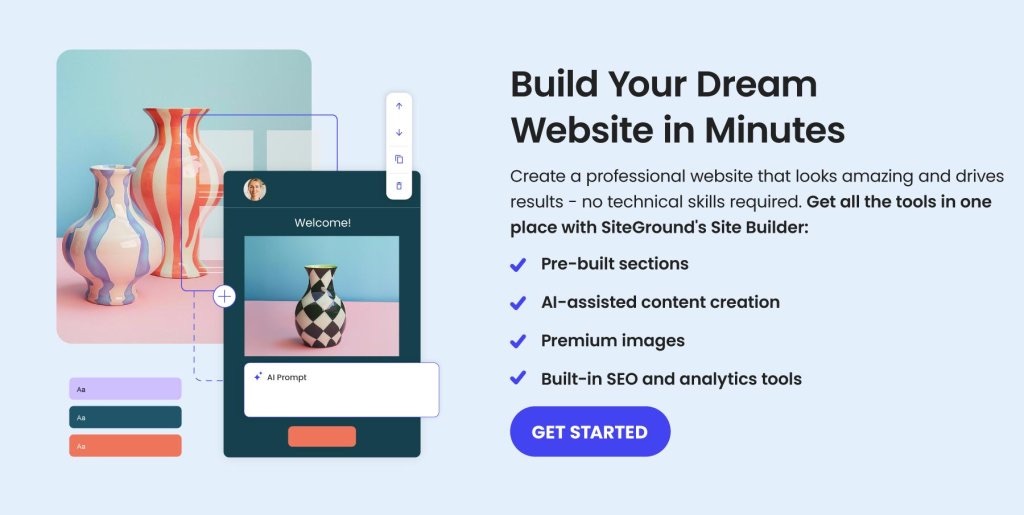

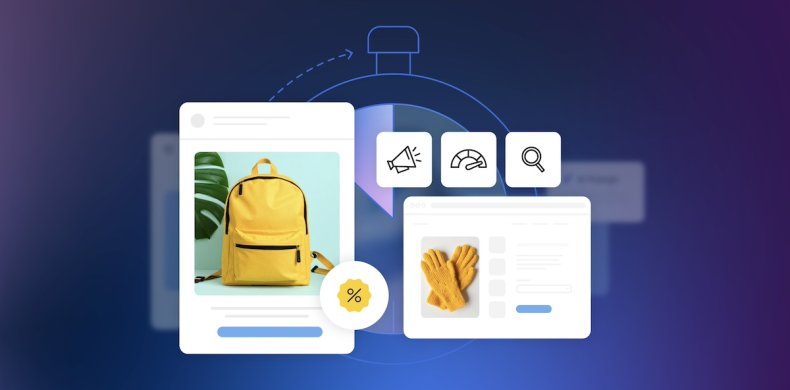
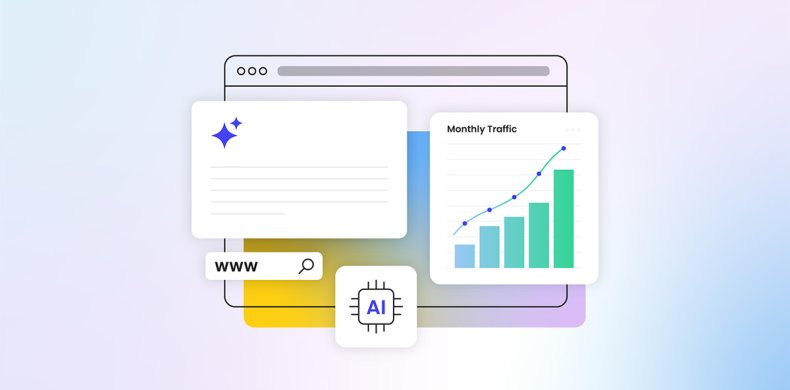

Comments ( 0 )
Thanks! Your comment will be held for moderation and will be shortly published, if it is related to this blog article. Comments for support inquiries or issues will not be published, if you have such please report it through our official channels of communication.
Leave a comment
Thanks! Your comment will be held for moderation and will be shortly published, if it is related to this blog article. Comments for support inquiries or issues will not be published, if you have such please report it through our official channels of communication.